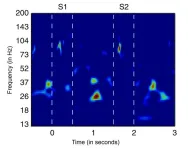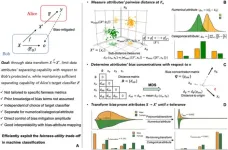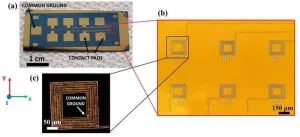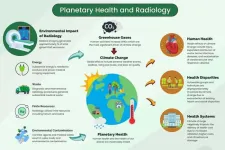(Press-News.org) To properly protect forests and evaluate the state of natural resources, conservation practices and environmental policies, it is important to have accurate information on an area’s forest extent. One of the challenges facing researchers when it comes to evaluating the accuracy of forest extent, however, is that models use different remote sensing products that may have different definitions for what determines forest extent. In addition, on the ground surveys may sometimes come into conflict with what remote, satellite-based products are describing as forests.
To help quantify this problem, a group of researchers from the University of Delaware teamed up with an international group of collaborators. Together, they looked at forest extent estimates from seven regional and global land or tree cover remote sensing products across Mexico, using two independent forest inventory datasets gathered by researchers on the ground—one on a national level and one on a local level—to verify the accuracy of the remote sensing products.
Forest Extent Agreements and Disagreements
Using this information, they were able to develop a forest extent agreement map for Mexico, combining the seven products and the two datasets and identifying the consensus areas of agreement in their estimates.
The research was funded by the National Aeronautics and Space Administration Carbon Monitoring System program of the United States and the results of the study were recently published in Environmental Research Letters.
The lead author on the paper was Dustin Braden, who received his master’s degree from UD in 2023. Pinki Mondal, assistant professor in the Department of Geography and Spatial Sciences in UD’s College of Earth, Ocean and Environment and one of Braden’s advisors, was a co-author on the paper. During his time at UD, Braden was co-advised by Mondal and Rodrigo Vargas, professor of Ecosystem Ecology and Environmental Change in UD’s College of Agriculture and Natural Resources and Director of the Water Science and Policy program.
Using the different data, the researchers were able to find areas where the satellite products agreed on forest extent and where they disagreed—finding that high agreement tended to occur in heavily forested areas such as the Yucatan Peninsula and mountain areas in the Sierra Madre Oriental and Sierra Madre Occidental. High disagreement tended to occur in complex ecological zones such as the tropical dry forest and subtropical mountain system, where the varied tree cover can lead to inconsistencies in remote sensing analysis.
Braden said that, ideally, the researchers would like to have high correlation between the remote sensing products and the on the ground data but admitted that is a pretty lofty goal.
“There’s always going to be differences just because they’re different methods,” said Braden. “What someone is doing on the ground all day, walking through these places and measuring these data versus what the satellite can pick up, it’s always going to be a little bit different which just makes sense.”
However, now that they’ve identified where the products agree and where they disagree, further research can be taken to see what exactly is causing the disagreement. The information could also be helpful to researchers on the ground who are collecting data for Mexico’s National Forest Inventory.
“Maybe the researchers collecting data might use something like this to say, ‘Ok, here’s this region where some products from satellites are identifying it as forested and some aren’t. We should probably get some better data here, on the ground, to see what exactly is happening,’” said Braden. “There’s a whole bunch of reasons they might be getting confused. Satellites might be misidentifying shrubs as forest or, for example, they might just not see trees where there are trees. So, that’s a useful insight that goes beyond the national forest inventory data.”
END
New research develops forest extent map for Mexico
Ensuring accuracy of forest extent helps conservations protect forests
2024-04-23
ELSE PRESS RELEASES FROM THIS DATE:
In the brain, bursts of beta rhythms implement cognitive control
2024-04-23
The brain processes information on many scales. Individual cells electrochemically transmit signals in circuits but at the large scale required to produce cognition, millions of cells act in concert, driven by rhythmic signals at varying frequencies. Studying one frequency range in particular, beta rhythms between about 14-30 Hz, holds the key to understanding how the brain controls cognitive processes—or loses control in some disorders—a team of neuroscientists argues in a new review article.
Drawing on experimental ...
New mitigation framework reduces bias in classification outcomes
2024-04-23
We use computers to help us make (hopefully) unbiased decisions. The problem is that machine-learning algorithms do not always make fair classifications, if human bias is embedded in the data used to train them — which is often the case in practice. To ease this "garbage in, garbage out" situation, a research team presented a flexible framework for mitigating bias in machine classification. Their research was published Apr. 8 in Intelligent Computing, a Science Partner Journal.
Existing attempts to mitigate classification bias, according to the team, are often held back by their reliance on specific metrics of fairness and predetermined ...
Zap Energy achieves 37-million-degree temperatures in a compact device
2024-04-23
In the nine decades since humans first produced fusion reactions, only a few fusion technologies have demonstrated the ability to make a thermal fusion plasma with electron temperatures hotter than 10 million degrees Celsius, roughly the temperature of the core of the sun. Zap Energy’s unique approach, known as a sheared-flow-stabilized Z pinch, has now joined those rarefied ranks, far exceeding this plasma temperature milestone in a device that is a fraction of the scale of other fusion systems.
A new research paper, published this month in Physical ...
Magnetic microcoils unlock targeted single-neuron therapies for neurodegenerative disorders
2024-04-23
WASHINGTON, April 23, 2024 — Neural stimulation is a medical technique used to treat many illnesses affecting the nervous system. It involves applying energy to neurons to encourage them to grow and make connections with their neighbors. Treatments for epilepsy can often include neural stimulation, and similar treatments exist for Parkinson’s disease, chronic pain, and some psychiatric illnesses.
In the Journal of Vacuum Science & Technology A, by AIP Publishing, researchers from the University of Minnesota deployed an array of microscopic coils — microcoils — to create ...
Laser-treated cork absorbs oil for carbon-neutral ocean cleanup
2024-04-23
WASHINGTON, April 23, 2024 – Oil spills are deadly disasters for ocean ecosystems. They can have lasting impacts on fish and marine mammals for decades and wreak havoc on coastal forests, coral reefs, and the surrounding land. Chemical dispersants are often used to break down oil, but they often increase toxicity in the process.
In Applied Physics Letters, by AIP Publishing, researchers from Central South University, Huazhong University of Science and Technology, and Ben-Gurion University of the Negev used laser treatments to transform ordinary ...
COVID-19 vaccination and incidence of pediatric SARS-CoV-2 infection and hospitalization
2024-04-23
About The Study: The findings of this study including 3.9 million children suggest that vaccination against SARS-CoV-2 was associated with significant reductions in COVID-19 incidence and hospitalizations among children in California.
Authors: Justin V. Remais, Ph.D., of the University of California, Berkeley, is the corresponding author.
To access the embargoed study: Visit our For The Media website at this link https://media.jamanetwork.com/
(doi:10.1001/jamanetworkopen.2024.7822)
Editor’s Note: Please see the article for additional information, including other authors, author contributions and affiliations, conflict of interest and ...
Long-term taste and smell outcomes after COVID-19
2024-04-23
About The Study: Taste dysfunction as measured objectively was absent one year after exposure to COVID-19 while some smell loss remained in nearly one-third of individuals with this exposure, likely explaining taste complaints of many individuals with post–COVID-19 condition in this study of 340 individuals with and 434 individuals without prior COVID-19. Infection with earlier untyped and Alpha variants was associated with the greatest degree of smell loss.
Authors: Shima T. Moein, M.D., Ph.D., of the University of Pennsylvania ...
Artificial intelligence to be used for the detection of common eye disease
2024-04-23
Dry Eye Disease (DED) is one of the more common eye diseases, affecting up to 30% of the world’s population. This disease can affect many different types of people and can wind up being a great hindrance to their overall quality of life. Early screening and prognosis is vital to the patient’s progression with the disease. However, this can be difficult. In this study, researchers aim to use artificial intelligence (AI) to aid in early screening and prognosis of DED. Not only can the use of AI make screening more accessible for ...
A roadmap for digital neuroscience
2024-04-23
Neuroscience has entered a new, digital phase. The combination of brain research with supercomputing in large-scale, multi-disciplinary research collaborations has enabled an innovative approach to deciphering the brain, using powerful scientific technologies and data ressources. These developments open up new possibilities for brain research, medicine and technology. A position paper by over 100 authors, now published in the journal Imaging Neuroscience, summarises the current status and identifies ...
Radiologists propose actions to combat climate change
2024-04-23
OAK BROOK, Ill. – A diverse writing group—lead by authors at the University of Toronto—have developed an approach for radiology departments and practices to reduce their greenhouse gas emissions and become more resilient to the effects of climate change. They outlined their action plan in a Radiology in Focus article, published today in Radiology, a journal of the Radiological Society of North America (RSNA).
“Rising greenhouse gas emission levels lead to climate change, extreme weather events and worsening air pollution with downstream adverse health effects,” said lead author Kate Hanneman, M.D., M.P.H., vice chair of research ...
LAST 30 PRESS RELEASES:
Neuroscientists devise formulas to measure multilingualism
New prostate cancer trial seeks to reduce toxicity without sacrificing efficacy
Geometry shapes life
A CRISPR screen reveals many previously unrecognized genes required for brain development and a new neurodevelopmental disorder
Hot flush treatment has anti-breast cancer activity, study finds
Securing AI systems against growing cybersecurity threats
Longest observation of an active solar region
Why nail-biting, procrastination and other self-sabotaging behaviors are rooted in survival instincts
Regional variations in mechanical properties of porcine leptomeninges
Artificial empathy in therapy and healthcare: advancements in interpersonal interaction technologies
Why some brains switch gears more efficiently than others
UVA’s Jundong Li wins ICDM’S 2025 Tao Li Award for data mining, machine learning
UVA’s low-power, high-performance computer power player Mircea Stan earns National Academy of Inventors fellowship
Not playing by the rules: USU researcher explores filamentous algae dynamics in rivers
Do our body clocks influence our risk of dementia?
Anthropologists offer new evidence of bipedalism in long-debated fossil discovery
Safer receipt paper from wood
Dosage-sensitive genes suggest no whole-genome duplications in ancestral angiosperm
First ancient human herpesvirus genomes document their deep history with humans
Why Some Bacteria Survive Antibiotics and How to Stop Them - New study reveals that bacteria can survive antibiotic treatment through two fundamentally different “shutdown modes”
UCLA study links scar healing to dangerous placenta condition
CHANGE-seq-BE finds off-target changes in the genome from base editors
The Journal of Nuclear Medicine Ahead-of-Print Tip Sheet: January 2, 2026
Delayed or absent first dose of measles, mumps, and rubella vaccination
Trends in US preterm birth rates by household income and race and ethnicity
Study identifies potential biomarker linked to progression and brain inflammation in multiple sclerosis
Many mothers in Norway do not show up for postnatal check-ups
Researchers want to find out why quick clay is so unstable
Superradiant spins show teamwork at the quantum scale
Cleveland Clinic Research links tumor bacteria to immunotherapy resistance in head and neck cancer
[Press-News.org] New research develops forest extent map for MexicoEnsuring accuracy of forest extent helps conservations protect forests






